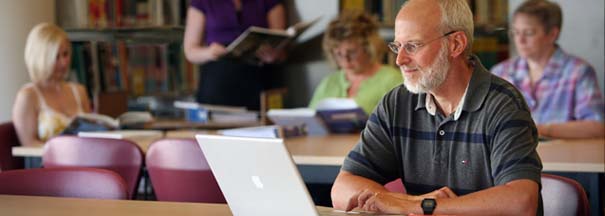
At first sight, the Curriculum Laboratory looks like any university library, with a sea of tables and endless rows of books.
But a closer look reveals a bustling hub, filled with students collaborating on course projects, professors teaching teachers-in-training and working teachers perusing the collection for new classroom materials.
The facility is a shared resource that embodies the community spirit of the University of Lethbridge Faculty of Education, explains coordinator Bill Glaister. “This is a place to gather and support each other.”
Collaboration between the U of L’s main library and the Faculty of Education, the lab is supported by a generous donation from Darol and Evelyn Wigham, the parents of an education alumna. It houses thousands of titles related to curriculum planning and instruction for students from kindergarten to Grade 12.
Education student, Ivy Waite, has spent a lot of time in the facility, either attending courses or conducting research for classes. “Anything you may need, you will find,” she says.
The fifth-year student started her last practicum at Winston Churchill High School this fall and says the Curriculum Laboratory is a big help. “I’m so grateful to have the staff, resources and space of the lab to help me prepare for the final steps of my degree.”
Like Waite, Roxane Holmes found the lab to be an enormous boost to her education as an undergraduate. It’s a resource she continues to use 16 years later, when she’s doing class planning for Grades 1 and 2.
“They have all of the resources, so if you’re looking at getting a new curriculum, you can go through (the collection) and see what you want to get before you spend the money,” she says.
Holmes often borrows hands-on tools like pop-up books and three-dimensional models for her classroom.
Faculty of Education professor and Curriculum Laboratory user, Dr. Robin Bright, says the resources are delightfully up-to-date, particularly the children’s literature section. “We house exemplary children’s literature and it’s the best literature that’s available.”
Bright, who often teaches in the lab, says the space is conducive to having students learn to teach. The facility includes a reading corner, for instance, where students can practice reading to children. “It’s not just the materials, it’s also the space.”